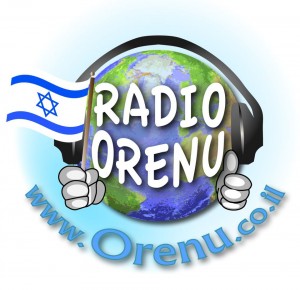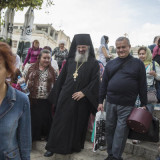OLD SYNAGOGUE, NOW A MESSIANIC CONGREGATION
 Some months ago, L.A. County Supervisor Zev Yaroslavsky was “cruising Boyle Heights,” the neighborhood where he grew up and where a large portion of Los Angeles’ Jewish community once lived. Feeling nostalgic, he drove by B’nai Jacob Synagogue — once known as the Fairmont Street Shul — and recalled that some of his parents’ students had celebrated their bar mitzvahs there.
Some months ago, L.A. County Supervisor Zev Yaroslavsky was “cruising Boyle Heights,” the neighborhood where he grew up and where a large portion of Los Angeles’ Jewish community once lived. Feeling nostalgic, he drove by B’nai Jacob Synagogue — once known as the Fairmont Street Shul — and recalled that some of his parents’ students had celebrated their bar mitzvahs there.
On this visit, however, Yaroslavsky noticed something he hadn’t before: the old shul’s exterior was in excellent condition and displayed the same Jewish symbols it had decades ago. There were Magen Davids, menorahs, Mosaic tablets … Yaroslavsky wondered if he was in a time warp — Boyle Heights as it was in 1950.
“I knew it couldn’t be a synagogue,” Yaroslavsky told the Journal, “because there aren’t enough Jews in Boyle Heights to make up a minyan.” Then he saw a banner: Iglesia Israelita Casa de Dios — Israelite Church House of God.
Inside, the longtime supervisor — and well-known mover-and-shaker in local politics and the Jewish world — found an immaculate sanctuary, its pews upholstered in red velvet, looking as beautiful as it had been in its Jewish heyday. The chandeliers were the original ones, upgraded with energy-efficient bulbs. The two bimahs displayed menorahs and Mosaic tablets.
There were no crosses or other Christian imagery.
On the Saturday Yaroslavsky visited — as on every Saturday — a Spanish-language religious service was going on, attended by about 100 people of all ages. Men and women sat separately. The women wore modest clothing and covered their heads with shawls; the men wore suits and ties, their heads uncovered.
Adam Velazquez, 56, one of the group’s leaders, approached Yaroslavsky and explained: They hold services on Shabbat — Friday night and all day Saturday, but not on Sunday. They follow Leviticus dietary laws. At their services, they recite the Ten Commandments and the Shema — in Spanish. They observe Passover, Shavuot and Sukkot, but not Christmas or Easter.
To Yaroslavsky, as to most people, that sounded Jewish.
But wait. They also worship “Yahshua” (Jesus) as their Messiah, who, they believe, was sent by God to redeem humanity.
Similar to groups called “Messianic Jews,” the iglesia (church) practices elements of Judaism while also believing that Yahshua (Yah-SHU-ah) is the son of God.
So they’re clearly not Jews. But they’re not traditional Christians, either.
Then what are they? And why does their iglesia, inside and out, look like a shul? And how did it get from what it was then to what it is now?
B’nai Jacob Synagogue was first dedicated as an Orthodox shul in 1927. In subsequent years, the period in which many Jews lived in Boyle Heights, the shul was active and crowded.
During the years following World War II, Jews started moving out of Boyle Heights; by the 1970s only a few worshippers remained. So, in 1979, B’nai Jacob went on the market. The Iglesia Israelita made a bid and bought it.
This movement had begun in Guadalajara, Mexico, in the 1920s when a group of Mexicans concluded that Yahshua and his disciples were observant Jews who prayed, ate and celebrated as Jews. This group’s assessment was that from the second century onward, as Christians from non-Jewish backgrounds took control of Christianity, they increasingly separated it from Yahshua’s Jewish roots.
In founding their movement — Iglesia Israelita Casa de Dios — the Guadalajara group’s aim was to seek a religious experience shaped by Yahshua’s first-century Jewish practices and beliefs: they would pray, eat and celebrate together like the Jewish Yahshua and his disciples did 2,000 years ago.
“What the founders of our church did was to seek the truth of the original Scriptures,” Velazquez said. By this, he means the Tanakh and the Gospels, both of which are referred to repeatedly in this congregation’s Points of Faith.
In these points, they lay out the importance of Leviticus dietary laws, observance of Shabbat, celebration of Jewish holy days and other biblical elements familiar to Jews. The Points of Faith also talk about Yahshua as the divine and only begotten son of God, of his sacrifice for mankind and future return, and of the importance of baptism — immersion into “living waters” — as an act of repentance.
After Iglesia Israelita’s founding in 1923, its adherents took their doctrines to other parts of Mexico, to Central America and eventually to the United States. At present, there are eight branches in the United States and dozens in Latin America.
In 1960, Iglesia members in Los Angeles pooled their resources and bought a small place of worship in City Terrace, near Boyle Heights. The group eventually looked for larger space, which is how they came to buy B’nai Jacob Synagogue in 1979.
One of the conditions of the sale, which Iglesia members entirely agreed with, was that the building would not be altered, inside or out.
“Judeo-Christianity,” or Messianic Judaism, is still a relatively small blip on religion’s radar screen, but in Latin America and in Latino communities in the United States, it’s growing. Conservative Rabbi Daniel Mehlman, who has presided over many conversions to Judaism, sees this movement as “problematic.”
“The Iglesia is not trying to convert Jews to their beliefs,” he said. “But on the other hand, they call themselves Judeo-Christians; whether it’s deliberate or not, there’s a degree of deception in that … because Jesus is central to their ideology.”
Mehlman, who was born and raised in Buenos Aires, Argentina, is concerned because groups like the Iglesia — which behave as Jews, because that’s what Yahshua and his disciples did — can be confusing to Latinos who want to convert to Judaism.
“I’ve participated in the conversion of about 150 Latinos,” Mehlman said, “and messianism is a problem. … When Latinos wanting to convert to Judaism enter a place like the Iglesia, they might stay there.”
That’s possible, of course; but if so, it’s not because the Iglesia practices charismatic worship — they don’t. In its gentleness, the Iglesia is the opposite of rapturous religious frenzy.
Their prayer sessions are soft-spoken and their study sessions are a mix of textual analysis and therapy session. These gatherings are gentle and healing, and after each person speaks, the volunteer leader, whoever it happens to be, says “Gracias.”
They call each other “brother” and “sister,” and it’s more than automatic habit — it’s a way of life for this group, which operates like an extended family.
As people file out of the service, they greet each other with “Paz a vos,” which means: Peace unto thee. Shalom aleicha. The language, too, is aimed at creating a first-century Hebrew-Christian experience.
If you understand Spanish and spend time with this group, it’s abundantly clear that Iglesia members have put their reverence for Christianity’s Jewish roots into practice. They don’t — like Christians did for many centuries — reject, obscure or denigrate those roots. Instead, they celebrate them.
Whatever one may think about the religion — or religious services — going on nowadays at the Fairmont Street Shul, it’s hard not to feel, as Yaroslavsky did when he visited, that the stately old place is in hands that take good care of it.











Look, the word sect is problematic, it’s better to use a word congregation. I mean the following sentence: “… to repeatedly in this sect’s Points of Faith …”